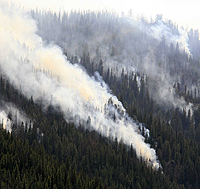Almost 330,000 more acres have been charred by wildfires in Idaho this year compared to last, and the Boise-based National Interagency Fire Center is warning that the potential for additional blazes between now and November is above normal.
As of Tuesday, a total of 875,518 acres had burned across the state since the fire season began. That is 573,029 acres more than the three-year average, from 2003 through 2005. Last year, a total of 547,460 acres burned in Idaho.
For the last few weeks, wildfires in Idaho intermittently smothered the Wood River Valley under a blanket of hazy smoke, which crept as far south as Colorado.
Tom Wordell, a fire analyst for the National Interagency Fire Center, said the active season is due largely to periods of extremely dry weather coupled with frequent dry lightning storms.
"In Central Idaho and the mountains, it's about instability," Wordell said.
He said there have been frequent periods of high pressure—dry, hot weather—followed by storms that produce a lot of lighting and not much rain.
"When everything is in alignment, that's when you get the large acreage gains," he said.
What may seem strange is that the active fire season followed one of the wettest winters in Southern Idaho in the last 25 years. By comparison, the 2004 fire season, which followed a meager, dry winter, consumed a remarkably low 18,482 acres.
Wordell said the large-scale wildfires in the timber forests of Idaho typically don't become a threat until late July, when upper-elevation snowpacks are long gone, and the fuels are sufficiently dried out. In 2004, periodic rains kept fuel moistures high through July and by mid-August "significant rains came and ended the fire season."
This year, the rains didn't fall.
"When you think about this year compared to that year, a lot of large fire activity has occurred during August and early September, which is when, in 2004, they didn't have conditions that would sustain big fire growth," Wordell said.
Randy Richter, a forest aviation and fire staff officer for the Sawtooth National Forest, said he's had a "hard time characterizing the year."
"We can't really describe it," he said.
Three fires on the Sawtooth National Forest have required the management of an incident command team, which "is unusual for this forest," Richter said. "That hasn't occurred in 12 years."
The Trailhead Fire, which at times posed a threat to homes near Stanley, was initially declared controlled July 31, 12 days after it ignited 10 miles southwest of Stanley on the western edge of the Sawtooth Wilderness.
But on Aug. 22, gusty, hot winds coupled with extremely low humidity caused the blaze to re-ignite and jump its original containment lines. The blaze aggressively charged north and east toward Stanley through tinder dry beetle-killed pine.
"Our weather stations recorded extended periods where the humidity was in the single digits," Richter said. "The max humidity was just 15 percent, which is not typical up there."
The blaze was declared 100 percent contained again on Sept. 8.
Despite the toll an active fire season takes on the landscape and resources—both human and natural—it is a necessary and vital function in healthy forests.
Fire suppression practices of the past have dramatically changed the overall health of the state's forests, depleting game herds and increasing the risk of bigger, hotter fires, argues Miles Benker, a habitat biologist with the Idaho Department of Fish and Game.
Fire-dependent tree species like aspen and ponderosa pine have also suffered, he said.
"Earlier this month, U.S. Sen. Mike Crapo, R-Idaho, toured the Clearwater Region by airplane and pledged to see that more fires are allowed to burn on federal lands to benefit elk habitat," Benker recently wrote. "With the return of fire and selective timber harvest to the landscape, forest health, wildlife populations and their habitat and hunting opportunities will improve."
But how much is too much?
The severity of wildfire seasons ebb and flow naturally over time, but climatologists and fire scientists are warning that global warming will only make bad years worse.
"All indications are, we will surpass the record we set last year in terms of acreage burned," Wordell said.
In 2005, wildfires in the United States consumed a record 8,689,389 acres. As of Sept. 12, 2006, a total of 8,653,883 had burned across the country.
"It's just staying drier and warmer longer," Wordell said. "Warmer temperatures and rapid snowmelt make higher elevation fuels able to ignite earlier in the season."
This November, global warming and its impact on wildfires will be the focus of the International Fire Congress' annual meeting in San Diego.
"Human-induced climate change and wildland fire management are multi-faceted and span many disciplines," Robin Wills, president of the Association of Fire Ecology, said in a press release. "Planning for wildfire requires a staggering amount of cooperation and communication between diverse groups. We're going to bring those groups together in San Diego this fall."


 The Potato Fire north of Stanley burned several thousand acres of timber this summer. It was one of many fires that are collectively adding up to one of the most destructive fire seasons in history. Express file photo
The Potato Fire north of Stanley burned several thousand acres of timber this summer. It was one of many fires that are collectively adding up to one of the most destructive fire seasons in history. Express file photo



































